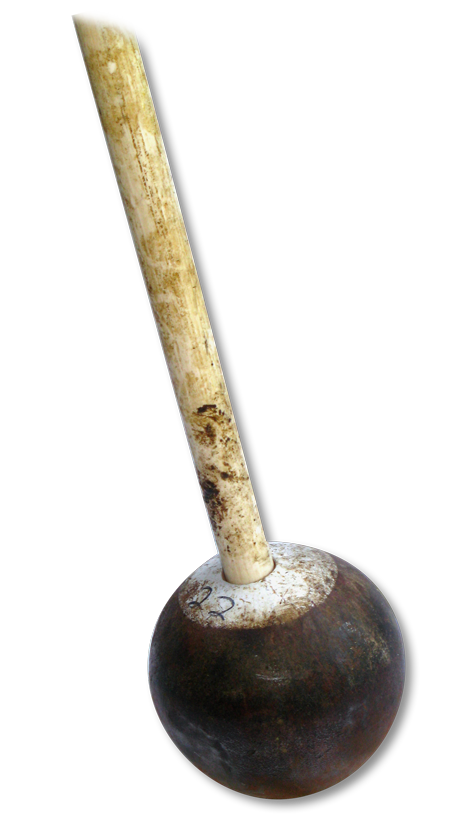SHA Athletic Rules
SECTION I: GENERAL EVENT RULES
- Conduct of the Distance Events – Stone Putt, Weight Throw, and Hammer Toss
- Each competitor shall be allowed three throws in each distance event.
- The competitor may start and stop their throw and it will not count as an attempt provided the implement does not leave their hand and the competitor has committed no foul. If the competitor desires to set the implement down or step out of trig area, they may do so only with the judge’s permission.
- In the stone putt and weight throw the measurement shall be taken to the nearest mark in the ground made by the stone or the weight, not the handle, the point which the measurement is taken from depends on the trig configuration and is described in Section 1.2.d. below. In the hammer throw the measurement shall be made from a point on the inside edge of the trig closest to the center of the competitor's stance, to the nearest mark in the ground made by the head of the hammer not the handle.
- Placing shall be determined by the best legal throw.
- In the event of a tie, placing shall be determined by the next best throw(s).
- In the event of a tie for first place, if the above method does not determine a first place winner then additional throws shall be made to try to break the tie. If, after a maximum of three additional throws, there is still no winner then the event shall be declared a tie.
- Ties for places other than first, not broken by the next best throw(s) are to be declared ties.
- In the event of a tie, the points for the places shall be added together and divided evenly among the tied competitors.
- At the conclusion of the competition, the winner may be given three attempts to try and set new records. The competitor may use all, some, or none of these extra attempts. The best legal throw shall be recorded as a new record if the old one has been broken. Extra throws shall not be used in determining points with regard to a decathlon scoring system.
- Configuration of the Throwing Area for the Distance Events
- The Trig is to be made of wood. It shall measure 4 foot 6 inches long and 5½ to 6 inches high. Every effort shall be made to secure the trig to the ground so that it will not move during the event if a competitor steps against it.
- All areas beyond the frontline (which includes all parts of the trig except the inside vertical face) and behind the backline are out of bounds and contact with any of these areas by any part of the competitor’s body during an attempt shall be a foul and count as an attempt whether the implement has been delivered or not.
- For the stone putt the backline shall be set at 7'6" from the trig. For the weight throw the backline shall be set 9' from the trig. No backline is used in the hammer throw.
- In the stone putt and weight throw two sideline configurations are allowed:
- The box configuration has sidelines that are perpendicular to the trig and set even with its edges so that the distance between the sidelines is 4' 6". The competitor must start with at least one foot completely within the sidelines and must finish with at least one foot completely within the sidelines. It is a foul if two consecutive foot falls contact the ground beyond the sidelines. It is a foul if any part of the competitor’s body other than the feet contacts the ground beyond the sidelines. Measurements shall be taken from the point on the inside edge of the trig closest to where the competitor's plant or front foot was placed.
- The wing configuration has wings that extend out from each edge of the trig at a 45 degree angle for a distance of roughly 18", the sidelines then continue perpendicular to the trig all the way to the backline. With the exception of the leading 45 degree wings, the sidelines are parallel and not more than 6'9" apart. All areas beyond the sidelines are out of bounds and contact with any of these areas by any part of the competitor’s body during an attempt shall be a foul and count as an attempt whether the implement has been delivered or not. The wings may be either painted lines, or extensions of the trig board itself. All measurements shall be taken from the point at the center of the inside edge of the trig board.
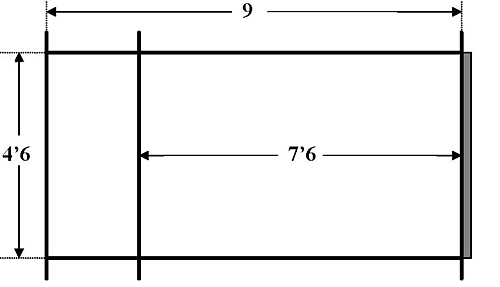
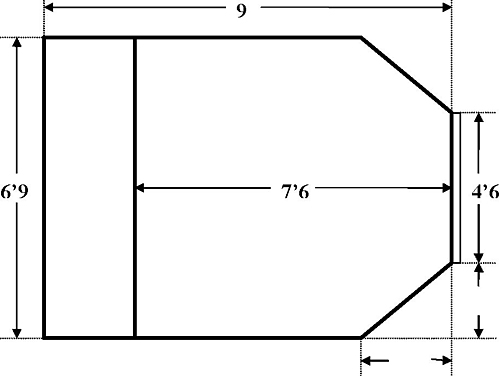
- In the hammer throw no sidelines are used. The competitor must have at least one foot directly behind the trig at all times during the throw and after the release of the hammer (i.e. one foot must remain within the confines of an imaginary box configuration).
- In all throws, if the implement lands behind the plane of the trig the throw is a foul.
- Conduct of the Height Events – Weight over the Bar and Sheaf Toss.
- Standards similar to those used in the pole vault should be used. Two configurations are allowed:
- Knockoff bar: The crossbar should sit on pins that extend perpendicularly from the uprights; the crossbar should not be attached to the uprights, so that if the implement hits the bar it will generally be knocked off. If the implement goes over the bar, the attempt is good whether or not it hits the bar provided the bar is not knocked off the pins.
- Fixed bar: The crossbar is physically attached to the uprights so that if the weight hits the bar it will remain in position. If the implement goes over the bar, the attempt is good whether or not it hits the bar.
- The distance between the uprights shall not be less than 8’ nor more than 12’.
- The judge has full discretion to establish the starting height and all subsequent heights. However, it is important that all decisions concerning the height of the bar should be made in consultation with the competitors.
- The starting height shall be divisible by 12". The bar should be raised in increments of 1’ (2’ for sheaf) until five or fewer competitors remain, after that the competitors may request any increment divisible by 3" (6" for sheaf). For record attempts only, the bar may be set at any height divisible by 1".
- All measurements shall be made from the ground to the top of the crossbar at its lowest point.
- The implement must go over the bar within the uprights.
- A competitor shall have the discretion to commence at the starting height or at any subsequent height.
- A competitor may pass any height at any time; however, a competitor who forgoes an attempt at a height thereby forfeits the right to attempt again at that height. Such competitor may, however, attempt that height if needed to break a tie for first place.
- Three consecutive failures, regardless of the height at which such failures occur, disqualifies the competitor from further attempts except as necessary to break a tie for first place.
- The winner shall be the competitor who tosses the weight or sheaf over the highest height. Placing is then determined by the next highest height and repeated until all places are filled.
- In the event of a tie, the competitor with the lowest number of attempts at the height at which the tie occurs shall be awarded the higher place.
- If the tie still remains, the procedure described above is repeated at each successively lower height until all ties are broken or all previous heights have been considered.
- If the tie still remains:
- If it concerns first place, the competitors tying shall have one more attempt at the current height. If no decision is reached, the bar shall be lowered (if all have failed) or raised (if two or more have cleared) by an amount determined by the judge. The tying competitors shall then make one attempt at each height until the tie is decided. In the process of breaking a tie a pass shall be considered a missed attempt. The competitors may elect to accept the tie provided all competitors involved in the tie agree.
- If it concerns any other place, the competitors shall be awarded the same place in the competition.
- In the event of a tie, the points for the places shall be added together and then divided evenly among the tied competitors.
- Any passes at heights lower than the final height successfully made by the competitor shall be considered as made attempts in the determination of final placing.
- Where all competitors have failed except one, that competitor is entitled to continue until he has missed three consecutive attempts. The highest height reached shall be used in determining points with regard to a decathlon scoring system.
- Standards similar to those used in the pole vault should be used. Two configurations are allowed:
- Measurements shall be recorded to the lowest half inch in all the events.
- The ground surface on which the competition shall take place shall be as flat as possible.
- If an implement breaks during the throw or while in the air, it shall not count as a throw provided it was made in accordance with the rules. In the event that the competitor thereby loses balance and commits a foul, it shall not be charged.
- When an implement is broken during a competition, a suitable and equal implement shall be substituted and the competition continued. If the judge does not feel that a suitable and equal implement has been substituted, then at the judge’s discretion, the round in which the implement was broken shall be repeated with the distances originally recorded in that round disregarded.
- Metal implements shall be made of a metal not softer than brass, or of a shell of such metal filled with lead or other material. If a filling is used, it must be inserted in such a manner that it is immovable. Implements that do not conform to these requirements will be considered illegal for use or for record consideration.
- No device of any kind (e.g. weightlifting straps) that in any way assists a competitor when making a throw shall be allowed. Only the following are accepted:
- The use of tape on the wrist, hand, and fingers is allowed, however the taping together of two or more fingers is forbidden. Any use of tape to protect the hands and fingers should be cleared with the judge before the event starts.
- The use of gloves is allowed in all events except for the stone putts.
- In order to obtain a better grip, competitors may use a suitable substance on their hands (or gloves) only. In the stone putts, a suitable substance may also be applied to the neck area.
- The use of toe spikes for the hammer throw is allowed.
- The use of weightlifting belts and supportive wraps is allowed. 10. A time limit of two minutes shall be applied in each individual attempt in all events. The two minute time limit shall begin when the judge announces the competitor’s name. In the event that a competitor follows himself in successive attempts, he shall be allowed three minutes.
- Open Stone Putt Suggested weights for this event are in the range of 16 to 20 pounds for the men, and 8 to 12 pounds for the women. Because of the nature of the implement considerable variation in the weight is allowed.
- The implement shall be of stone and as close to spherical as possible.
- The stone shall be putt from the shoulder with one hand only.
- At the time the competitor takes a stance to commence a putt, the stone shall touch or be in close proximity to the neck or chin, and the hand shall not be dropped below this position during the act of putting.
- The stone must not at any time be brought behind the line of the shoulders.
- Braemar Stone Putt Suggested weights for this event are in the range of 20 to 28 pounds for the men, and 13 to 18 pounds for the women. Because of the nature of the implement considerable variation in the weight is allowed. The same rules apply as in the open stone putt except that no approach is allowed, the competitor must make a standing throw. The competitor is allowed to reverse (switching the feet upon releasing the stone).
- Weight Throw Standard weights for these events are 28 and 56 pounds for the men, and 14 and 28 pounds for the women. Masters and Novice competitors may throw a 42 pound weight instead of a 56 pound weight.
- The weight shall be made of metal and consist of a spherical or box weight with a chain and handle attached. The handle may be a ring, triangle, or a "D" shape. The implement shall not measure more than 18 inches in overall length from the bottom of the weight to the top of the handle. The official weight of each implement is the total weight, including the handle.
- The competitor may use either hand to throw the weight, but only one hand may be used.
- Any style may be used to throw the weight as long as it is deemed safe by the judge. d. The competitor may start and stop their throw provided that no part of the implement has made contact with the ground or the trig board during the aborted attempt. If the implement has made contact with the ground or the trig board after the attempt was initiated and prior to receiving permission from the judge, then the attempt will be a foul.
- Hammer Toss Standard weights for these events are 16 and 22 pounds for the men, and 12 and 16 pounds for the women
- The hammer shall be spherical and made of metal, and the shaft shall be of wood, rattan or plastic. Cast iron is recommend over other metals and rattan is recommended over wood or plastic. The implement shall not measure more than 50 inches in overall length from the bottom of the weight to the top of the handle. The official weight of each implement is the total weight, including the handle.
- The hammer shall be thrown in a standing style. Although some movement of the feet prior to the release is allowed, there shall be no approach and the competitor is not allowed to spin the body.
- The competitor in the starting position, prior to the preliminary swing, is permitted to rest the head of the hammer on the ground on either side of the trig, or on the trig board itself. d. It shall not be considered a foul throw if the hammer touches the ground beyond the trig or the trig itself at the beginning of an attempt. After initiating the swings it shall be a foul if any part of the hammer touches the ground beyond the trig, or the trig itself.
- Weight Over the Bar Standard weights for this event are 56 pounds for the men and 28 pounds for the women. Masters and Novice competitors may throw a 42 pound weight instead of a 56 pound weight.
- The weight shall be of metal and consist of a spherical or box weight with a triangle, ring, or "D" handle attached. Cast iron is recommended over other metals. The implement shall not measure more than 18 inches in overall length from the bottom of the weight to the top of the handle. The official weight of each implement is the total weight, including the handle.
- The competitor may use either hand to toss the weight, but only one hand may be used.
- Any style may be used to toss the weight as long as it is deemed safe by the judge.
- Sheaf Toss Standard weights for this event are 16 or 20 pounds for the men, and 12 pounds for the women. Because of the nature of the implement some variation in the weight is allowed.
- The sheaf shall be a burlap bag filled with straw, hay, pine needles or rope. It is recommended that two or three bags be put over each other so that the sheaf will last through the whole competition. The bag shall not measure more than 36 inches long by 24 inches wide. A bag smaller than this is recommended. It is recommended that a 16# sheaf be used. If the standards will not reach high enough for the competition to be completed with a 16# sheaf, then a 20# sheaf should be used.
- The toss is made using a pitchfork with a 5foot nominal handle.
- Any style may be used to toss the sheaf as long as it is deemed safe by the judge.
- Competitors may bring their own pitchforks but it is understood that any competitor may use any pitchfork that will be used in the competition.
- Caber There is no standard size or weight of a caber, but when possible the caber chosen should be able to be turned by approximately ½ of the class. A challenge caber should be of a length and weight beyond the power of all but the best competitors to turn. The caber is to be made of wood, although metal may be substituted when deemed necessary. It is recommended that a back judge and a side judge be used. The caber shall be placed upright by the stewards in balance, with the heavy end uppermost, ready for the competitor to make his attempt. As soon as the competitor receives the caber and the stewards stand clear, the attempt commences. The judge may set boundaries if he feels the ground in a certain area is not suitable for the caber to be tossed. Safety should be a primary concern and the caber should not be too close to the spectators at any time during the toss. The competitor may take any length of run he wishes and may toss the caber from where he chooses, as long as it is within the judge’s boundaries. If the competitor allows the caber to fall before lifting it off the ground, this shall count as an attempt. If the competitor drops the small end of the caber back to the ground after having picked it up, this also counts as an attempt. Where the ground is uneven a mark should be made from near which, and not beyond which, the toss shall be made. Under no circumstances shall a fixed trig or stance be used. The caber must be judged on its landing position, not the position to which it may bounce or roll. The caber must pass through the vertical position in order to count as a turned caber. The vertical position is 90 degrees and it is up to the side judge to determine if the caber has passed through it. The “clock face method” of judging shall be used. The caber in a perfect toss will pass through the vertical position and land with the small end pointing directly at 12 o’clock in an imaginary straight line extending from the competitor through the initial landing point and in line with the direction of the run. An overhead view is drawn below to demonstrate a 12 o’clock toss.

A valid turn is when the small end of the caber passes through the vertical position and falls away from the competitor to land within the 180 degree radius, between 9 o'clock and 3 o'clock. An overhead view is drawn below to demonstrate some turned cabers and how they are scored.
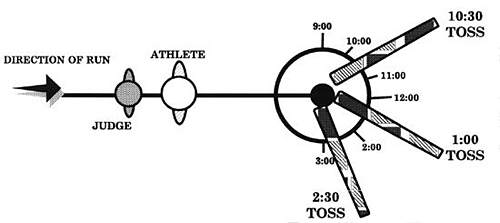
The direction of run is determined by the path taken once the competitor is deemed by the judge to be in control of the caber (this can be as little as the last two or three steps). The competitor may run in one direction and then stop and change direction, as long as they maintain control of the caber. If the caber lands in a 12 o’clock position pointing away from the competitor but not in a direct line with their run, then the judge must determine the competitor’s original direction of run and establish where a true 12 o’clock toss would be. He must then give an appropriate judgment based on the amount of deviation from the line.

If the competitor does not turn the caber, then it is the responsibility of the side judge to determine the angle at which the caber was tossed with respect to the 90 degree vertical. The side judge should be perpendicular to the competitors' line of approach in order to make an accurate call. A picture of a view from the side judge’s position is shown below.
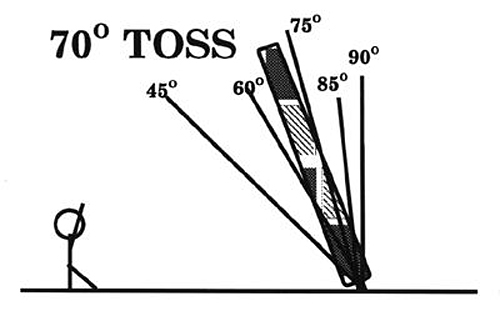
Each competitor is allowed three attempts, the best of these to count in the determination of his placement in the competition. The order of placing shall be determined by the nearest to 12 o'clock toss made by a competitor. If the competitor did not turn the caber, then placing shall be determined by the toss closest to the 90 degree vertical. In the event of a tie, the place shall be determined by the next best attempt(s). If this does not produce a first place winner one additional attempt by the tied competitors shall be made. If a winner is not determined by this additional attempt, then the event shall be declared a tie. Ties for places other than first not broken by the next best attempts shall be declared a tie. If the caber has not been turned after one complete round, then the judge may cut or substitute the caber. The caber shall be cut from the large end by an amount determined by the judge. This process can be repeated until the caber has been turned. If the caber breaks during the competition, placing is determined by all completed rounds. If fewer than two full rounds have been completed, and a caber of equal size and difficulty is available then all three rounds of the caber may be repeated. If a qualifying caber is used then any successful turn qualifies the competitor for the next caber. - After each completed event, the competitor who threw first is now placed last in the next event and everybody moves up one place. This is repeated after every event.
- The one point scoring system is recommended. In this system a competitor receives points depending on placing in each contested event, one point for a first place finish, two points for second place, and so on. The competitor with the fewest accumulated points after all of the events have been contested is the overall games winner. If there is a tie for first overall then the winner shall be the competitor with the most first places in the individual events. If this does not produce a winner, then the competitors remain tied. Other scoring systems (e.g. decathlon scoring) may be used provided that the competitors are informed of the scoring method to be used before the start of the competition.
- A competitor must make at least one attempt in every event in order to place in an overall competition.
- In the interest of safety, the judge has the right to disqualify any competitor who, in the judge’s opinion, does not have the ability to complete a throw without undue risk of injury to himself, other competitors, or spectators. The judge also has the right to disqualify any competitor who displays poor sportsmanship or engages in inappropriate conduct.
- Many games include local events or use local rules as a matter of tradition (e.g. 100# Braemar stone putt). It is the responsibility of the Athletic Director to announce any local events of rules in writing well in advance of the games. This announcement should be included on the games application and on the waiver form.
- The field judge in conjunction with the athletic director of a game may make on the spot rules variations to accommodate the participation of disabled athletes. All such changes should be made with safety as the preeminent concern.
- The athletic director of a game may establish objective classes for that game. Some examples are Masters, Lightweight, Novice, etc.
SECTION II: SPECIFIC EVENT RULES
SECTION III: GENERAL RULES OF COMPETITION
Download a copy of the SHA Athletic rules.


 Visit us on Facebook
Visit us on Facebook